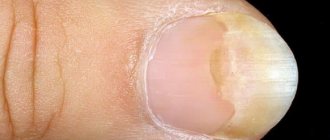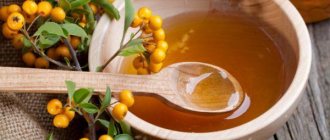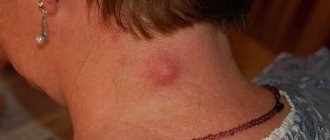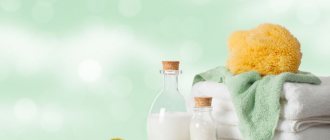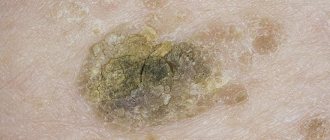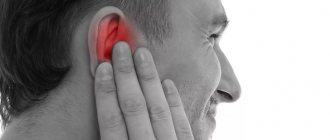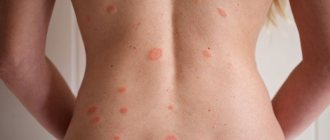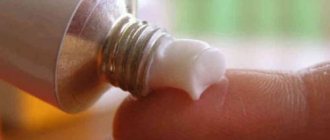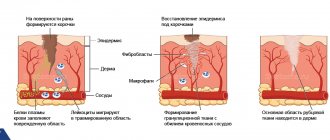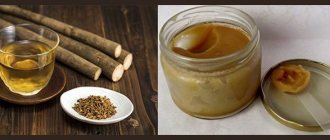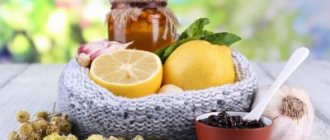Neurodermatitis (or, as it is also called, “atopic dermatitis”, “diffuse neurodermatitis”) is a dermatological disease that appears for internal reasons. The majority of patients are children; usually all patients develop a chronic course of the disease, that is, it becomes impossible to cure it. Almost every second patient with a skin disease suffers from neurodermatitis.
Symptoms of the disease return a short time after the course of treatment. In children, the disease is called diathesis.
Causes of neurodermatitis
It is impossible to become infected with neurodermatitis from contact with a person who has it. The causes of the disease lie within the patient himself, since the disease occurs for endogenous reasons. Mostly people with a hereditary predisposition to an allergic reaction to most (or all) allergens get sick.
Experts list the following main factors influencing the occurrence of the disease:
- Violations of the emotional, nervous state of the patient. The load on him mentally and physically, breakdowns, stress.
- Use of medications.
- Climate influence.
- Working in unsuitable conditions.
- Poor functioning of the immune system and nervous system.
- Bacterial infection.
- Impaired functioning of the gastrointestinal tract.
- Improper hormone production.
All of the above reasons are not the main ones for neurodermatitis. The main reason remains a predisposition to allergies. This reason has been proven by statistics, since most patients with neurodermatitis also have patients in their family.
Preparing for treatment
Having decided to treat such an unpleasant disease at home, you should reconsider your style and rhythm of life; some habits will have to be changed, while others will have to be categorically abandoned. By reducing the number of factors that provoke exacerbations, relapses are minimized and the body responds better to treatment.
Provoke exacerbations of neurodermatitis:
- stressful situations;
- allergens that get on the skin and inside the body;
- problems with the stomach and intestines.
Treatment of neurodermatitis at home begins with providing the patient with a calm atmosphere. It is necessary to protect him from disturbing situations and stress. You can use soothing teas and infusions. You also need to ensure sufficient activity, walks, and long sleep. In this way, the neurological component can be partially controlled.
Clothing must be made from natural fibers, excluding wool. Choose a gentle washing powder; it is better to wash clothes for the patient with baby or laundry soap. Eliminate allergens from food, spicy, sour, fried, smoked. Most of the diet should create an alkaline environment in the gastrointestinal tract (fruits, vegetables, legumes), and not an acidic one (sweets, bread, pickles, dairy products, red meat).
Considering the possibility of an allergic nature of neurodermatitis, before treatment it is necessary to minimize contact with any allergens. House dust causes 70% of allergies. Wet cleaning of the patient's apartment should be done daily. Shaggy carpets, pets, aquariums, and other allergens will have to be removed from the home. Contact with irritating substances can destroy the results achieved, and an exacerbation will occur.
It is necessary to cleanse the body with available means, treat diseases of the gastrointestinal tract, and eliminate the toxic effects of alcohol and nicotine. Now you can begin treating neurodermatitis with folk remedies.
Reasons for the development of the disease
To successfully treat neurodermatitis, it is necessary to understand the causes of the disease and the influence of which factors should be excluded in order to reduce the likelihood of exacerbations and progression of the disease.
The main causes of neurodermatitis include:
- genetic predisposition;
- long-term emotional problems, depression, stress;
- external exposure to high dust levels or harmful substances from the environment;
- unstable life schedule with disturbances in sleep and rest patterns;
- constant physical stress;
- long-term drug abuse;
- food intoxication;
- frequent contact with allergens (pollen, wool, dust, fluff);
- lack of sleep;
- mental stress;
- disruptions in the functioning of the gastrointestinal tract;
- infectious diseases;
- decreased immunity.
It is believed that the risk of suffering from neurodermatitis is higher if a person very often and in large quantities uses hygiene products with synthetic composition, and also drinks chlorinated water.
Note! If you have allergies, the more variety of foods in your diet, the higher the likelihood of neurodermatitis.
Both during treatment at home and for prevention purposes, it is important to completely eliminate the negative impact of all these factors from your life.
The simplest and most proven folk recipes
Since itchy rashes can cover a large area of the scalp, face, body, arms and legs, it is more convenient and effective to use medicinal baths with the addition of decoctions of medicinal plants. After the bath, homemade ointments are applied to the affected areas of the skin. Traditional medicine recommends the following recipes, available at home:
- Bath with wormwood. Traditional healers recommend collecting common wormwood, rinsing and drying the herb, then grinding it and pouring boiling water at the rate of one spoon of raw material per glass of liquid. After this, the mixture is infused until it cools completely, filtered and added to warm bathing water. One liter of decoction is enough for 10 liters of water. For a child, you can prepare a bath with a lower concentration of herbal infusion. The procedure is carried out every day, preferably before bedtime. The bath should be taken for about 10-15 minutes, then gently pat the skin dry with a soft towel or napkin and proceed to further measures. In the same way, you can prepare baths from nettle, burdock root, walnut partitions, and oak bark.
- Baths with blue or white clay. Clay can be bought at a pharmacy. Dissolve the powder in water at the rate of a tablespoon per liter of water, take a bath for 15-20 minutes, after which you should rinse with clean warm water and pat your skin dry. Baths with potato starch are made in the same way.
- Ointment based on interior fat and birch tar. To prepare this remedy, you should combine equal parts of any fresh and unsalted poultry fat, beeswax and birch tar. This mixture is heated in a water bath until all the ingredients are combined into a homogeneous mass. The mass should boil, after which it is removed from the water bath and cooled. Apply this product to the skin up to 3 times a day.
- Aloe ointment. You can also prepare an ointment with aloe juice based on internal fat. Agave leaves are chosen to be the fleshiest and oldest. First, they are kept in the refrigerator for several days, then they are crushed and the juice is squeezed out. The fat is melted in a water bath, then the juice is poured in at a ratio of 1:2, stirred well, heated and cooled. Also apply 2-3 times a day. Compresses with sea buckthorn. Fresh or frozen ripe sea buckthorn berries are crushed into a paste, spread on a piece of gauze and applied to irritated skin for 15-20 minutes. The compresses are secured on top with a bandage or napkin.
Almost all medicinal herbs and other components of organic origin in folk remedies can cause an allergic reaction if there is individual intolerance. Therefore, you should not use several different recipes at once, especially when treating children. You should start with one, wait a day to make sure there are no unwanted side effects, and then continue therapy or try a new remedy.
Symptoms of neurodermatitis
The most common symptoms of neurodermatitis are:
- Itching.
- Rashes.
- Inflamed areas of skin.
- Dryness and flaking.
Itching is the very first symptom of the disease; the skin begins to itch before a rash appears on it. Then the first foci of the disease appear, with shiny skin. At first they are light and merge with the skin, then they darken and unite. The skin on them peels off, becomes crusty, and has a dark color.
The area of the affected epidermis can vary in size and location.
Mostly outbreaks appear in the following places:
- Groin area.
- The area around the anus.
- Scrotum.
- Labia in women.
- Elbows, knees.
- Neck.
The most painful localization of neurodermatitis is the hands, because they are exposed to environmental influences, which can cause complications and pain.
The disease is accompanied by: a violation of the secretion of the adrenal glands, which causes skin pigmentation; inflammation of the lymph nodes. The patient’s weight decreases, as well as immunity, blood pressure, constant fatigue, nervousness, irritability, and sugar levels decrease.
Symptoms increase in winter and decrease in summer.
Find out more
Folk remedies for treating neurodermatitis
At home, skin pathology of the neuroallergic type is treated using ointments, creams, lotions, tinctures, and decoctions prepared using traditional methods. In addition to the main problem, it is recommended to pay attention to strengthening the immune system, while increasing the body’s ability to fight the disease.
Ointments for the treatment of neurodermatitis
Homemade ointment will relieve inflammation and soften the affected areas , which includes:
- 250 gr. butter;
- 100 gr. natural wax;
- 100 gr. resin;
- 50 gr. birch leaves and celandine;
- 0.5 l St. John's wort oil;
- 30 gr. chalk and birch buds.
Recipe:
- Mix butter and wax and bring to a boil.
- Add crushed resin to the mixture and boil everything.
- Add birch and celandine leaves into the resulting mass. Boil for five minutes.
- Place the pan with the solution in the oven, after adding chalk and St. John's wort oil to it. Simmer at low temperature for 2.5 hours.
- Add birch buds and cook for another 30 minutes.
- Cool and strain.
A linen napkin is moistened in the prepared ointment and applied to the affected areas. The course of treatment is long but effective. The ointment should be stored in a cool place.
The best treatment for neurodermatitis is the use of clay . It is recommended to use clay or healing mud from salt lakes. If there are no salt lakes nearby, then you can use any clay. To do this, you need to dilute it with warm water and spread it on the inflamed areas of the skin. While the clay dries, dilute a few tablespoons of salt in a bowl of water and pour the resulting solution over yourself, washing the clay off yourself. Usually, after just a few procedures, the skin stops peeling and itching.
You can treat lesions with such a folk remedy as propolis-based ointment. To prepare it, Vaseline and lanolin (1:1) are mixed in a water bath. Then crushed propolis is gradually introduced into the resulting mixture and everything is mixed well until smooth.
Diseased areas of the skin with neurodermatitis, as well as with other skin diseases, can be treated with an ointment, which includes:
- any poultry fat;
- beeswax;
- Birch tar.
All ingredients are mixed in a clay pot and placed on a hot surface (baking tray or bricks) for 4 hours. Then the composition is brought to a boil, and after 20 minutes removed from the heat. After straining and cooling, the ointment is ready.
Types of neurodermatitis
There are several types of neurodermatitis. They differ in symptoms and their strength of manifestation.
Limited neurodermatitis
The affected areas with this type of neurodermatitis have boundaries and are located only in one area of the skin. Papules usually appear in the neck, knees, elbows, around the anus, and in the groin. They are located symmetrically, on both sides, the color of the rashes is dark. The epidermis dries out and peeling appears. The patches may spread to healthy areas and are characterized by shiny papules.
Limited neurodermatitis is accompanied by severe dryness of the skin; there is no weeping after opening the papules. The affected areas are flaky, and the peeling and crusting is white with a grayish tint. Beneath them are pigmented areas. Itching in focal areas bothers all patients. It intensifies at night and upon contact with an irritant.
Diffuse neurodermatitis
Dermatologists also call this type atopic dermatitis. The disease is characterized by a more severe course. During its course, several affected areas appear, which have the usual localization for neurodermatitis: elbows and knees, groin, area around the anus, face, neck.
Characterized by severe itching. Patients experience wetness of the skin when scratching it. This can cause infection as infections spread to open wounds.
In children, the disease is localized in the hair on the head and in the eye area. During adolescence, symptoms in children disappear.
Hypertrophic neurodermatitis
This type is not often diagnosed. The variety is characterized by rashes on the thighs and groin areas. Patients experience severe itching and wart-like formations.
Linear neurodermatitis
Symptoms of this variety appear on the elbows and knees, are expressed in stripes, and are characterized by dryness.
Acute follicular neurodermatitis
The species was named because of the shape of the papules - they are characterized by a pointed shape and are located in areas with hair follicles.
Depigmented neurodermatitis
With this neurodermatitis, depigmentation manifests itself most strongly - white spots appear on the skin.
Psoriasiform neurodermatitis
This type is usually diagnosed if the patient has white scales on the skin, usually in the head and neck area.
Forecast and prevention of neurodermatitis
Since neurodermatitis does not threaten dangerous complications, the prognosis is the most favorable for life, although complete recovery does not occur in all cases. When the cause of neurodermatitis lies in deep allergic-genetic structures, it is impossible to exclude relapses, because therapeutic measures may not cover all manifestations of the disease. Diffuse neurodermatitis with severe exacerbations can lead to long-term loss of performance. Limited neurodermatitis does not tend to become diffuse, which is why its prognosis is much more favorable.
Preventing neurodermatitis is not easy. Preventing the development of complex forms of neurodermatitis is possible if childhood exudative diathesis (eczema) is treated in a timely manner, and if you immediately consult a dermatologist when the first symptoms of the disease appear in adolescents, men and women. The following precautions should be taken:
- protect the sick person from stress, strong feelings, anxiety and depression;
- temporarily change the usual climatic and environmental conditions to places where there is sea or mountains, with a dry, hot climate;
- address existing health problems;
- establish the correct alternation of work and rest, normal sleep and hygiene.
Traditional medicine methods using herbal decoctions and ointments can be successfully used in the treatment of neurodermatitis.
With proper treatment and compliance with all the rules, neurodermatitis goes away very quickly, leaving no noticeable marks on the skin.
Classification
There are several types of neurodermatitis and each type of pathology has its own characteristics. Let's take a closer look at each of these forms of the disease.
Limited form
Limited neurodermatitis is a form of the disease in which there are complaints of a rash only in a clearly limited part of the skin.
With this type of pathology, the lesions are concentrated in the following areas:
- on the neck;
- in the groin area;
- in the genital area;
- in the anal part;
- in the cubital fossa;
- under the knees.
The nature of the rash in this form of pathology is as follows:
- lesions have a clear round shape;
- often symmetrical;
- pink or brown;
- the skin in these places is dry;
- the edges of the affected area are clearly colored.
With focal neurodermatitis, the skin lesions do not become wet. The skin turns red and becomes covered with crusts and scales. Severe itching is felt, intensifying at night.
Diffuse form
With diffuse neurodermatitis, skin dermatitis is more severe. Multiple lesions form on the human body. Neurodermatitis occurs on the arms, legs, under the knees, and in the elbows. Neurodermatitis on the face, including on the cheeks, lips and nose, may become wet for a short time due to scratching, but without external influence the wounds quickly dry out.
Important! If the disease develops in childhood, the scalp and areas around the eyes are affected.
Hypertrophic form
Hypertrophic neurodermatitis is the rarest form of pathology, in which lesions form on the inner side of the thigh and in the groin.
Patients note severe itching, infiltration and lichenification of the skin. The disease can be complicated by warty formations.
Other forms of the disease
The following neurodermatitis is much less common:
- linear (localized in the folds, between the fingers, looks like stripes);
- follicular (papules form along the mouths of the hair follicles);
- depigmented (skin loses pigment and turns white);
- decalvating (affects the skin where there is vellus hair and leads to its loss);
- psoriasiform (red lumps with silvery scales, mainly on the head and neck).
Whatever form of pathology occurs, it must be diagnosed as soon as possible.
Neurodermatitis: symptoms and treatment with folk remedies
It is necessary to notice the symptoms of the disease in time, then the treatment of neurodermatitis will be effective. The first symptom is severe itching, which begins to bother the patient before a rash forms. Over time, small bubbles with a characteristic shine appear. At first they do not differ from the color of the skin, then they begin to acquire a pinkish-brown tint. Later they merge into a common focus, covered with crusts and scales. The lesion is not clearly defined, without smooth boundaries.
The skin in these places first turns blue and then acquires a reddish tint. At the same time, old lesions become discolored. The disease most often occurs in skin folds: the groin, intergluteal fold, under the knee, neck, labia, scrotum.
You may also be interested in:
- It is important to know whether shingles is contagious or not? Causes and treatment
- Treatment of demodicosis in humans - effective methods of treatment on the face and eyelids read here
- Good to know - how to treat scabies at home https://idermatolog.net/boleznikogi/paraziti-kozi/chesotku-v-domashnih-usloviyah.html
- Treatment of streptoderma in adults using modern methods, read here
- Lipomatosis, what is it, causes and photos of the disease
Top
Neurodermatitis in adults
Neurodermatitis in adults is called atopic dermatitis. It appears extremely rarely in adults; on average, one percent of all patients with neurodermatitis are adults. More than half of them are women. People most often get sick in large cities.
In adults, neurodermatitis may be accompanied by inflammation of the lymph nodes.
Treatment of neurodermatitis in adults is no different from that in children. Adults also need to follow a diet and give up bad habits and foods. The patient should get enough sleep, walk more often and experience light physical activity, but avoid fatigue and irritability. Treatment of neurodermatitis in adults does not take place in a hospital, but on an outpatient basis.
To get acquainted, look at the photos of symptoms of neurodermatitis in adults on the face, head, arms, legs.
Treatment of neurodermatitis in adults
The mechanism of how to treat neurodermatitis in adults is a complex measure. The process can be carried out on an outpatient basis; hospitalization is required only in severe cases. A favorable prognosis for neurodermatitis in adults is established in most cases. A limited type of disease is easily treatable. Experts use the following methods to cure neurodermatitis forever:
- providing the patient with appropriate care, which includes regular nutrition, feasible physical activity, timely rest and sleep;
- hypoallergenic diet;
- vitamin therapy;
- the use of local drugs that relieve itching and inflammation;
- in severe cases of neurodermatitis, hormone therapy is prescribed;
- the use of antihistamines to relieve the effects of allergens;
- the use of drugs that stabilize the nervous system;
- physiotherapy.
Local treatment with drugs
In addition to tablets that are taken orally, you should use an ointment for neurodermatitis. Such remedies have a local effect and help relieve the symptoms of the disease. Doctors can prescribe 2 types of drugs for adults:
- corticosteroids;
- non-hormonal.
Ointments with glucocorticoids should be used by adults under the supervision of a specialist, as they can cause side effects. Apply the product in a thin layer without rubbing. Therapy with such drugs for neurodermatitis should be carried out once a day. Local medications help stabilize hormonal levels and prevent relapse of the disease in adults. Doctors prescribe the following drugs: Dermovate, Cyclocort, Akriderm GK, Chalcinonide cream for neurodermatitis.
- How to start losing weight at home
- Signs of HIV in women
- Streptocide ointment - instructions for use. What does streptocidal ointment help with, composition and analogues
Non-hormonal ointments for neurodermatitis in adults help reduce the severity of symptoms. Such products relieve itching, soften the skin, dry out pimples, and have an anti-inflammatory effect. Popular non-hormonal drugs are:
- Naftaderm - a medicine for neurodermatitis in adults eliminates inflammation, reduces itching, and heals the skin.
- Radevit – starts the process of tissue regeneration, contains vitamins.
- Gistan - used to relieve itching and prevent neurodermatitis and atopic dermatitis in adults.
- Desitin – contains zinc oxide, which has anti-inflammatory and antiseptic properties.
Physiotherapeutic procedures
The phototherapy procedure, pine or salt baths and phototherapy for neurodermatitis in adults are one of the important components of complex treatment. Physiotherapy is recommended after the end of the exacerbation period; its course is up to 15 sessions. To calm the nervous system, suggestive therapy and electrosleep are recommended for adults. If neurodermatitis is limited, doctors may prescribe the use of electrophoresis and mud wraps. Staying in sanatoriums and resorts has a positive effect on the health of adult patients.
Diet
Proper nutrition for neurodermatitis in adults involves avoiding foods that contain large amounts of carbohydrates, salt, and the use of seasonings. During the acute period, it is forbidden to eat food containing allergens and harmful substances:
- meat and fish of fatty varieties;
- food with added artificial flavors and colors;
- seafood;
- citrus;
- eggs;
- chocolate;
- whole milk.
Drinking clean water will be a useful dietary habit - adults need to drink at least 2 liters of it per day. The diet for neurodermatitis should be based on certain products:
- fresh vegetables and fruits;
- low fat fermented milk products without additives;
- dietary varieties of boiled meat;
- porridge;
- low-fat broths;
- drinks: rosehip decoction, green tea, compote, mineral water.
Treatment of neurodermatitis at home
In most cases, neurodermatitis is treated at home. Hospital therapy is indicated only in severe cases of the disease in adults. At home you can use natural folk remedies and medications. Medicines, especially hormonal ones, should be selected by a doctor individually. If you notice symptoms of neurodermatitis, be sure to go to the hospital to determine the cause of the disease.
ethnoscience
Traditional methods of treatment will help eliminate neurodermatitis:
- Baths with wormwood have antibacterial properties, prevent the development of inflammatory processes, and heal skin with neurodermatitis. First you need to make an infusion: pour 1 liter of boiling water over a glass of dry herb, cook for 10 minutes. over low heat. Leave the prepared liquid for half an hour, then pour it into the bath. The therapeutic agent should act on the body of an adult within 15 minutes.
- Homemade ointment will help eliminate focal neurodermatitis. To make it, grind propolis and mix it with lanolin melted in a water bath. Apply the resulting preparation to areas affected by neurodermatitis.
- Constant itching due to neurodermatitis often causes nervous disorders in adults; to calm down, make a special infusion. Take equal parts of angelica leaves, lemon balm, burdock and valerian roots, and violet flowers. Mix all ingredients well. 2 tbsp. l. collection, pour 0.5 liters of boiling water, leave in a thermos for about 10 hours. Adults should drink the resulting drink 50 ml after meals, after filtering.
Neurodermatitis in children
Neurodermatitis in children is called diathesis.
The percentage of all people suffering from neurodermatitis among children is much higher than among adults (about 98.5-99%). As in most cases, children suffer from neurodermatitis due to an allergic reaction to any irritants, such as wool, dust, pollen, any food, or individual intolerance to any substances.
Children can also get sick due to disorders of the nervous system.
Neurodermatitis in children should be treated only as prescribed by the attending physician. The treatment regimen depends on many factors, such as the patient's age, health status, symptoms and stage of the disease. Typically, children develop only one lesion.
In case of complications, a large erythematous area with a papule appears, all the rest merge. When opening the papules, weeping may appear.
Other symptoms of neurodermatitis in children include:
- Peeling of the epidermis.
- Skin pattern.
- Dermographism is a type of urticaria in which light streaks appear on the skin.
The darkest areas expand and affect healthy ones. In infants, rashes appear on the head, neck, elbows, and knees, but by the age of three, symptoms usually subside in children.
In a teenage child, symptoms of neurodermatitis appear on the elbows, hands, knees, and face.
Various forms of medications are used to treat neurodermatitis, including:
- Vitamin complexes, including retinol, group B, E.
- Hormonal preparations: ointments, creams.
- Antihistamines, that is, reducing the manifestation of an allergic reaction.
- Sedatives and sleeping pills.
The diet for illness should include fermented milk products, poultry meat, quail eggs, fish, natural juices, and sweets are prohibited.
Familiarize yourself with the manifestations of neurodermatitis in children from the photo.
Reasons for the development of pathology
In most cases, neurodermatitis is the body's response to food allergens . In addition, the development of the disease leads to:
- stressful situations,
- neuropsychological stress,
- heredity,
- weak immunity,
- diseases of the autonomic and central nervous system,
- interaction with various allergens,
- poisoning,
- poor quality food,
- inadequate physical and mental stress,
- medications,
- chemical substances.
Limited neurodermatitis
The classic symptoms of neurodermatitis of a limited type are as follows:
- chronic inflammatory process;
- long, persistent, long-term course of the disease;
- short-term and incomplete remissions;
- infiltration;
- thickening and roughening of the skin (lichenification);
- severe (uncontrollable) itching, concentrated in certain areas of the skin.
Infiltration in limited neurodermatitis manifests itself in the penetration of cellular elements and chemical substances into the skin tissue. Lichenification is expressed by the fact that the skin pattern becomes furrowed, rough and rough.
The course of neurodermatitis in children and adults begins in the same way - the patient feels an unbearable itch in a certain area of the skin, which does not go away even after scratching it, but only intensifies. Then characteristic rashes appear, which are dense papules rising above the surface of the skin. These elements soon merge and form dry, red plaques that stand out against the background of unaffected skin.
Despite the fact that the development of limited neurodermatitis occurs in a small area, the suffering caused by the disease to a person is real torment. Itching overcomes the patient most often in the evening or at night. As the disease progresses, the skin pattern also changes. All lines become exaggeratedly emphasized. The affected areas take on the appearance of shagreen skin.
Symptoms of neurodermatitis: zoning of disease foci
Limited neurodermatitis is characterized by a clear demarcation of the structure in the affected areas. There are:
- central (internal) part, characterized by infiltration and lichenification;
- the middle part, located around the central area, where shiny isolated papules are observed;
- peripheral area, expressed by pigmentation specific to limited neurodermatitis.
Fresh lesions lack a peripheral zone. There are types of limited neurodermatitis, when areas with infiltration and roughening of the skin may be the only ones in the clinic of the disease.
Typically, in the treatment of neurodermatitis, no more than two lesions are noted, but there are cases with a large number of pathological areas. The inflammatory process is accompanied by redness, against the background of which fresh scratches are found, covered with crusts of dried ichor. Where the patient has scratched the skin too hard, the surfaces bleed.
The rashes are most often dry in nature; they begin to become wet only after deep scratching. These areas dry out quickly, but if a pustular infection manages to join, the course of the disease and treatment of neurodermatitis will become more complicated.
Limited neurodermatitis in the acute stage
As the disease progresses, new scattered elements may appear in the areas of the rash. They are very itchy. Peeling intensifies in the central part of the lesions. Redness also becomes more pronounced.
Typical in the treatment of neurodermatitis is the following localization of lesions:
- back of the neck and back of the head;
- forearms;
- popliteal and elbow bends;
- shins;
- in men the scrotum;
- inner thighs;
- area around the anus.
If limited neurodermatitis is concentrated on the scrotum, in the perineal area and in the femoral folds, scratching, diaper rash and friction while walking can lead to the formation of giant areas of thickening and roughening of the skin. The vagina, anus, and scrotum are areas where the disease is particularly severe. Infiltration, inflammatory processes and lichenification reach the border of the mucous membranes of the genital organs.
Symptoms of neurodermatitis: how does it affect the nervous system?
Attacks of debilitating itching exhaust the nervous system. Treatment of neurodermatitis often occurs against the background of:
- significant disturbances in the functioning of the central nervous system;
- emotional instability;
- insomnia;
- mood variability.
All this affects the success of local therapy.
Neurodermatitis
In the limited version, skin lesions are usually represented by local itchy plaques no larger than the palm of the hand in the area of the back or side of the neck, inguinal-femoral folds, scrotum, labia, intergluteal fold. The changed areas of the skin are zones of lichenification, surrounded by disseminated papules along the periphery. In the late period of neurodermatitis, hyperpigmentation forms along the edges of the lesions, against the background of which, in places of scratching, secondary leukoderma can form - areas of discolored skin.
The formation of diffuse neurodermatitis, as a rule, is preceded by the presence of exudative diathesis in infancy, then childhood eczema, and, finally, atopic dermatitis itself (diffuse neurodermatitis). Typical localization of the lesion: face (forehead, cheeks, red border of the lips), neck, elbow and knee bends, chest, inner thighs. The skin in the affected area is dry, hyperemic, lichenified with excoriations, crusts, and foci of exudation; the boundaries of the changed skin are blurred. When the red border of the lips is involved, atopic cheilitis develops.
The leading symptom of neurodermatitis is painful itching of the skin, which intensifies at night. Intense itching causes the patient emotional and physical distress, leading to insomnia, irritability, neurotic personality changes, and depression. Scratching the skin is often accompanied by the formation of long-term non-healing wounds and the addition of a secondary infection. Complications of neurodermatitis may include folliculitis, impetigo, furunculosis, staphyloderma, hidradenitis, lymphadenitis, lymphangitis, fungal infection, viral lesions (molluscum contagiosum, simple and plantar warts, Kaposi's eczema herpetiformis), etc.
Other skin symptoms in diffuse neurodermatitis include dark circles under the eyes, longitudinal suborbital folds (Denny-Morgan lines) under the lower eyelids, deep palmar and plantar folds, and keratosis pilaris. Patients with neurodermatitis are characterized by weakness and fatigue, weight loss, arterial hypotension, hypoglycemia; sometimes they have cataracts, keratoconus, nipple eczema, and ichthyosis. For diffuse neurodermatitis, exacerbations in the autumn-winter period and remissions during the warm season are typical.
Treatment of neurodermatitis with folk remedies
It is recommended to treat neurodermatitis at home using folk methods as a supplement to basic medications for adults and children; you can find many methods and recipes on the forums. The positive side of this therapy is that mostly natural ingredients do not cause an allergic reaction, which is possible only with individual intolerance. Such methods are cheaper and safer. At first, treatment is possible only with natural products, but only after consultation with your doctor.
There are many grandmother's recipes that effectively relieve the symptoms of neurodermatitis. In the fight against the disease, plant components are used; homemade ointments, compresses, lotions, and baths are made from them.
Recipes for the most popular and used remedies:
- It is recommended to make lotions and baths for hands and feet from herbal ingredients. According to patients, herbal treatment reduces the area of inflammation, redness, itching and other symptoms of neurodermatitis. The most popular herbs are chamomile and string; they are used for baths and for children. Nettle, plantain, mint, and oregano are also used. Tinctures are made from them and taken orally.
- Homemade ointments for the treatment of neurodermatitis are made from a base and a healing component. The first is a fatty product, such as lard. It is melted and sulfur is added to it. Ointments can be made from fat, wax, tar - all three ingredients make an excellent remedy for relieving inflammation, redness, itching, and normalizing skin condition.
- Compresses. Blue clay, sold in pharmacies or cosmetics stores, is an excellent help in the treatment of neurodermatitis. It is mixed with sea salt in a 1:1 ratio. Then add water to the mixture and apply to areas with the outbreak of the disease. When the clay dries, it is washed off with warm water.
Neurodermatitis: treatment with folk remedies
A disease such as neurodermatitis can and should be treated at home. Traditional methods of treating neurodermatitis together with medications are quite effective.
Ointment for neurodermatitis
- 100 g beeswax
- 100 g poultry fat
- 50 g Sophora japonica fruits
- 10 drops of birch tar
Finely chop the Sephora fruits. Place all ingredients in a clay pot. Place a brick on the stove and place the pot on it. The mixture should simmer for 4 hours. Remove from heat, cool. Use this ointment against neurodermatitis twice a day.
Top
Herbal ointment for neurodermatitis
- 50 g poultry fat
- 10 g calendula
- 10 g lily of the valley
- 10 g valerian
- 10 g eucalyptus
Finely chop all the plants and mix. Mix a tablespoon of the resulting mixture with poultry fat. Apply the ointment to the affected areas twice a day.
Top
Lard ointment
- 500 g lard
- 250 g purified sulfur
Melt lard over low heat in a frying pan. Strain the resulting mixture into a porcelain container. Add purified sulfur to the melted lard. Mix thoroughly until smooth.
Before using this ointment, you must first wash yourself with baby soap. Then rub the affected area with a terry towel. The skin should turn red. After this, you can apply the ointment. The procedure is carried out until complete recovery occurs.
If the ointment does not help, then you should change the ratio of lard and sulfur - take them equally. The resulting ointment should be stored in the refrigerator.
Top
Aloe ointment
- 50 g lard
- 50 g aloe juice
- 5 g fir oil
Melt lard over low heat. Add aloe juice and fir oil to it. Mix well and wait until the mixture hardens. The resulting ointment is used twice a day until complete healing. It must be stored in the refrigerator.
Top
Traditional methods of treatment
Skin diseases, including neurodermatitis, respond well to alternative methods of treatment, in parallel with the main one. Ointments for local therapy based on cucumber oil, black currant oil, and aspen oil are used. Also, these oils are produced in capsules for oral administration. As a folk remedy against itching, lotions made from rich decoctions of chamomile and sage are used. Homeopathic medicines help well. Particular attention should be paid to the diet for neurodermatitis, eliminating spicy foods and seasonings that provoke itching. In any case, it is necessary to seek medical help and resort to complex treatment, since treating neurodermatitis at home alone will not give the desired result.
Berry juices
To treat neurodermatitis at home, it is sometimes recommended to use juices from frozen or fresh berries, for example, raspberries, cranberries. Official medicine, however, allows the use of only sea buckthorn juice as the least irritating. This juice is applied topically to the affected areas at least 4-5 times a day in the form of regular rubbing or wetting. After application, it is not washed off, but left until completely dry. Increased itching or redness is considered a contraindication and suggests abandonment of this treatment method.
Treatment of neurodermatitis with medications
Since the disease is caused mainly by an allergic reaction, one of the most important points in the treatment of neurodermatitis is the use of antihistamines to reduce its manifestation. For this disease, a type of these drugs is used that simultaneously reduces the effects of histamine and does not have strong side effects.
First generation antihistamines are distinguished by the fact that they are effective and cause fatigue and drowsiness in the patient. These include Fenistil, Suprastin, Pipolfen.
Antihistamine tablets of the second and third generations are usually used, such as Ketotifen, Gistalong, Clarisens, Loratadine, Telfast.
Hormonal drugs are used only when other means do not help. They are effective in use, but they must be used very carefully so as not to cause complications and to avoid side effects.
Hormonal medications should be prescribed exclusively by the attending physician; independent choice of medications with hormones can cause complications. For neurodermatitis, if allergies cause severe symptoms with complications, hormonal medications with cortisone, hydrocortisone, dexamethasone, and prednisolone will also help.
If you use them according to the instructions, the treatment will be successful.
Hormonal ointments are divided into the following types:
- Weak. They act more gently and are not so dangerous. This includes Hydrocortisone ointment.
- Medium strength. Laticort, Lokoid, Triacort, Fluorocort.
- Strong ointments. Use only with a doctor's permission. Dermovate, Sinalar, Flucinar, Elokom.
Non-hormonal ointments and creams consist of natural or synthetic products; they treat neurodermatitis very effectively; reviews about them are mostly positive at the initial stage of the disease. They are less effective than hormonal ones, but they also have fewer side effects. Most of them can be used in unlimited quantities. They improve the condition of the skin; many conventional medications are comparable in effectiveness to hormonal ones. Doctors often prescribe Ski-Derm, Panthenol, Bepanten.
Neurodermatitis: folk remedies in the form of tinctures
Treatment of neurodermatitis with folk remedies can also be carried out using tinctures. They must be taken orally separately from medications.
Burdock root tincture
- 1 tablespoon burdock root
- 200 ml water
Grind the burdock root. Heat 200 ml of water and add the burdock. Boil for 15 minutes. Remove from the stove and wrap in a warm cloth. Leave for 2 hours. Drink the resulting tincture three times a day, one tablespoon at a time.
Top
St. John's wort tincture
- 15 g St. John's wort
- 150 g water
Pour boiling water over the St. John's wort collection. Leave for 2 hours. The resulting tincture is consumed after meals, one tablespoon at a time. The course of treatment is 20 days.
Top
Herbal tincture
- 15 g mint
- 15 g valerian root
- 20 g three-leaf watch
- water
One tablespoon of the resulting mixture of herbs is poured with a glass of boiling water. Leave for half an hour. You need to take this tincture 100 ml three times a day.
Top
Herbal tincture for neurodermatitis
- 5 g chamomile flowers
- 5 g nettle leaves
- 5 g oregano
- 5 g licorice root
- 5 g creeping thyme
- 5 g horsetail
- 7.5 g string
- 7.5 g valerian root
- 200 g water
Mix all the herbs and pour one glass of hot water. Bring the resulting mixture to a boil. Remove to slabs and let sit for one hour. Strain and consume 60 ml before meals.
Top
Bath with horsetail
- 150 g horsetail
- 2 liters of boiling water
Finely crushed raw materials are poured with 2 liters of boiling water. The resulting mixture is infused for half an hour and added to a warm bath. Take this bath for about 40 minutes daily. The course lasts 14 days.
Top
Clay compress
- 20 g blue clay
- 20 g sea salt
- water
Mix the clay with sea salt and add water. The consistency of the mixture should resemble sour cream. Apply the clay to the affected areas and hold until dry. Rinse off with warm water. This compress should be done daily for two weeks. The clay will dry the affected skin and eliminate itching.
Both treating neurodermatitis with folk remedies and preventing this disease requires courses of procedures. A single use will not give any effect.
Top
Prevention of neurodermatitis
To prevent relapse of the disease, a number of preventive measures must be followed.
- Follow proper nutrition and eliminate allergens from your diet. Experience light physical activity.
- Undergo procedures to enhance immunity.
- Try not to get into stressful situations.
- Do not wear shoes and clothes made of low-quality synthetic materials.
- Take care of the skin, but without resorting to chemical and mechanical effects on it (peelings, scrubs).
- Avoid temperature changes to avoid skin irritation.
Advantages of treatment of neurodermatitis at the PsorMak Institute
Treatment of neurodermatitis has long been successfully carried out by specialists from the PsorMak Institute of Healthy Skin, under the guidance of the chief physician - academician of the Russian Academy of Medical Sciences Vladimir Fedorovich Mak.
An effective treatment regimen for neurodermatitis
The PsorMak clinic has been using therapeutic techniques for many years that are aimed not only at relieving symptoms. Treatment of neurodermatitis additionally includes measures aimed at combating concomitant diseases. Depending on the condition, the patient is individually prescribed therapy against mycoses using antifungal drugs.
Among the most effective, safe and effective methods of treating neurodermatitis have proven themselves:
- Psychotherapy. Since neurodermatitis is often associated with a person’s psychological state, in some cases the help of a psychologist can be of significant help in combating the disease.
- Acupuncture and hirudotherapy. They show very good results in the treatment of neurodermatitis and other skin diseases that often cannot be treated with other methods.
- Local application of natural ointments. They are developed according to the PsorMak clinic’s own recipe without the use of hormonal components. Contains exclusively herbal ingredients that are not harmful to sensitive skin.
Using the form on the website, you can make an appointment directly with Mak V.F. or other experienced specialists at our clinic. If it is more convenient, call us at +7 (495) 150-15-14, and we will find a suitable appointment time for you.
Treatment with folk remedies
A disease such as neurodermatitis can and should be treated at home. Traditional methods of treating neurodermatitis together with medications are quite effective.
Ointment for neurodermatitis
- 100 g beeswax;
- 100 g poultry fat;
- 50 g of Japanese Sophora fruits;
- 10 drops of birch tar.
Finely chop the Sephora fruits. Place all ingredients in a clay pot. Place a brick on the stove and place the pot on it. The mixture should simmer for 4 hours. Remove from heat, cool. Use this ointment against neurodermatitis twice a day.
Herbal ointment for neurodermatitis
- 50 g poultry fat;
- 10 g calendula;
- 10 g lily of the valley;
- 10 g valerian;
- 10 g eucalyptus.
Finely chop all the plants and mix. Mix a tablespoon of the resulting mixture with poultry fat. Apply the ointment to the affected areas twice a day.
Lard ointment
- 500 g lard;
- 250 g of purified sulfur.
Melt lard over low heat in a frying pan. Strain the resulting mixture into a porcelain container. Add purified sulfur to the melted lard. Mix thoroughly until smooth. Before using this ointment, you must first wash yourself with baby soap. Then rub the affected area with a terry towel.
The skin should turn red. After this, you can apply the ointment. The procedure is carried out until complete recovery occurs. If the ointment does not help, then you should change the ratio of lard and sulfur - take them equally. The resulting ointment should be stored in the refrigerator.
Aloe ointment
- 50 g lard;
- 50 g aloe juice;
- 5 g fir oil.
Melt lard over low heat. Add aloe juice and fir oil to it. Mix well and wait until the mixture hardens. The resulting ointment is used twice a day until complete healing. It must be stored in the refrigerator.
Burdock root tincture
- 1 tablespoon burdock root;
- 200 ml water.
Grind the burdock root. Heat 200 ml of water and add the burdock. Boil for 15 minutes. Remove from the stove and wrap in a warm cloth. Leave for 2 hours. Drink the resulting tincture three times a day, one tablespoon at a time.
St. John's wort tincture
- 15 g St. John's wort;
- 150 g of water.
Pour boiling water over the St. John's wort collection. Leave for 2 hours. The resulting tincture is consumed after meals, one tablespoon at a time. The course of treatment is 20 days.
Herbal tincture
- 15 g mint;
- 15 g valerian root;
- 20 g three-leaf watch;
- water.
One tablespoon of the resulting mixture of herbs is poured with a glass of boiling water. Leave for half an hour. You need to take this tincture 100 ml three times a day.
Herbal tincture for neurodermatitis
- 5 g of chamomile flowers;
- 5 g nettle leaves;
- 5 g oregano;
- 5 g licorice root;
- 5 g creeping thyme;
- 5 g horsetail;
- 7.5 g string;
- 7.5 g valerian root;
- 200 g of water.
Mix all the herbs and pour one glass of hot water. Bring the resulting mixture to a boil. Remove to slabs and let sit for one hour. Strain and consume 60 ml before meals.
Bath with horsetail
- 150 g horsetail;
- 2 liters of boiling water.
Finely crushed raw materials are poured with 2 liters of boiling water. The resulting mixture is infused for half an hour and added to a warm bath. Take this bath for about 40 minutes daily. The course lasts 14 days.
Clay compress
- 20 g blue clay;
- 20 g sea salt;
- water.
Mix the clay with sea salt and add water. The consistency of the mixture should resemble sour cream. Apply the clay to the affected areas and hold until dry. Rinse off with warm water. This compress should be done daily for two weeks. The clay will dry the affected skin and eliminate itching.
Clay bags can be purchased at pharmacies or cosmetics stores.
Other recipes
Treatment of neurodermatitis in adults with folk remedies:
- plantain. Wash large leaves, lightly beat or cut until the juice releases. Apply to areas of rash. Inflammation is reduced, itching is reduced, microbes that enter the scratch areas are destroyed;
- yarrow. Brew 1 tbsp. l. flowers with a liter of boiling water. Strain the infusion after an hour. Suitable for compresses and lotions. You can simply wipe the affected areas with the infusion. Effective anti-inflammatory, wound healing agent;
- starch baths. Dissolve corn or potato starch in a liter of cold water. Pour the solution into warm water. Take a bath for 20–25 minutes. The procedure soothes the skin and reduces itching. Be sure to take a shower after a starch bath and gently pat your body dry;
- hop. Collect fresh cones and combine them with the string. Proportions – 1:1. You will need 2 tsp. raw materials. Pour 150 ml of boiling water over the mixture of string and hop cones. Cover the jar and let it brew. Drink a portion of healing infusion every evening;
- ointment with propolis. An effective product quickly heals affected skin and prevents the development of inflammatory processes in areas of scratching. Take 100 g of lanolin or cosmetic Vaseline, heat it, add 10 g of chopped propolis. Wait until it dissolves. Treat lesions twice daily;
- rub of rue leaves and peppermint. A simple, accessible method relieves itching and prevents flaking. Grind the herbs, pour two cups of boiling water over a dessert spoon of the mixture, and boil for 2 minutes. After an hour, strain the finished broth. In the evening, rub the desired areas, put on ironed linen made from natural fabrics;
- lard ointment. Take half a kilo of interior fat, melt, combine with 1 tbsp. purified sulfur. Stir thoroughly. Treat the outbreak with a disinfectant solution, apply a thin layer of homemade ointment, and cover with a clean cloth. Repeat 3 courses of 10 procedures each, break – 2 weeks;
- herbal compress. A composition that improves tissue regeneration is recommended. You will need raspberry, nettle, and strawberry leaves. Pour boiling water over dry or fresh raw materials (proportions 1:1), let it brew. Wet gauze folded in 2-3 layers or a clean napkin and keep the lotions for 2-4 hours. Re-wet the cloth as needed;
- mumiyo. The natural product relieves pain, normalizes the regeneration process, and heals wounds. Rub the ointment with mumiyo into the lesions. Take powder dissolved in milk for a week (mummy on the tip of a knife, 0.5 tbsp. warm milk, 1 tsp. honey). Drink the milk formula twice a day;
- burdock decoction. Grind a medium-sized root and pour a glass of boiling water over it. After an hour, strain and drink a glass of infusion. Drink the product twice a day. Do not prepare the infusion for future use; the method does not take much time;
- chamomile baths. Perfectly soothe the skin and reduce itching. Steam a tablespoon of dried flowers in a liter of boiling water. Half an hour - and the bath filler is ready. Time for the procedure is 20 minutes. There is no need to wash off the infusion.
Medicinal herbs
Some varieties of herbs have a wide range of effects on the body and skin. Drinking decoctions, adding them to the bath when bathing, or treating affected areas of the skin with infusions accelerates the tendency to recovery. Certain types of plants have an antiseptic effect and reduce the symptoms of the disease.
The following types of herbs are used in the treatment of neurodermatitis:
- chamomile;
- hop cones;
- series;
- St. John's wort;
- nettle;
- liquorice root;
- celandine;
- burdock;
- marsh marigold;
- valerian root;
- creeping horsetail.
When dealing with neurodermatitis, it is recommended to pay special attention to lifestyle and diet. Excessive physical and mental stress should be avoided. If you have an overly sensitive nervous system, it is necessary to prevent stress and depression with special medications. The diet should contain the maximum amount of vitamins and beneficial components.
Treatment options
Treatment of neurodermatitis at home includes several methods. Therapy with medicinal herbs and folk remedies has good indicators of effectiveness, but if complications occur, it is recommended to use medications. Before using them, it is important to consult with a specialist and carefully study the lists of contraindications specified in the instructions.
Pharmacy medicines
Neurodermatitis requires complex therapy. The list of medications used includes drugs from different groups, including potent drugs. A qualified specialist must draw up a course of treatment. Only a doctor can objectively assess the clinical picture of the patient’s health condition and identify the factors that provoked an exacerbation of atopic dermatitis.
Drugs used to treat neurodermatitis:
- antihistamines (Claritin, Tavegil, Diazolin);
- hyposensitizing drugs (sodium thiosulfate);
- neuroleptics (Thioridazine);
- sedatives (tinctures of valerian and motherwort);
- tranquilizers (Mebikar, Amizil).
Folk remedies
Alternative medicine recipes can be used not only to treat neurodermatitis, but also as a preventive measure. Natural components eliminate the inflammatory process well, accelerate cell regeneration and eliminate the consequences of skin rashes. Thanks to folk remedies, the period of remission of the disease can be significantly extended.
You can cure neurodermatitis using the following recipes:
- treatment with blue clay (mix sea salt and diluted blue clay in equal proportions, apply the preparation to the affected area of the skin and wait for it to dry, repeat the procedure daily for two weeks);
- ointment with herbs (mix valerian root, lily of the valley, calendula and eucalyptus in equal proportions, mix two tablespoons of lanolin or any fat with a teaspoon of the resulting preparation, use a skin treatment product);
- ointment with beeswax (mix any bird fat, tar and beeswax in equal proportions, place the preparation in a clay pot and leave to infuse for 4 hours in a preheated oven or on hot bricks, strain the mixture, cool and use to treat affected areas of the skin);
- lard, aloe juice and fir oil (mix 50 g of aloe juice with 5 ml of fir oil, add melted lard to obtain a homogeneous consistency, use a skin treatment product);
- infusion of Sophora japonica (pour two tablespoons of the fruits of the plant with a glass of boiling water; after infusion, the preparation can be used to treat affected areas of the skin or ingested).
Medicinal herbs
Some varieties of herbs have a wide range of effects on the body and skin. Drinking decoctions, adding them to the bath when bathing, or treating affected areas of the skin with infusions accelerates the tendency to recovery. Certain types of plants have an antiseptic effect and reduce the symptoms of the disease.
The following types of herbs are used in the treatment of neurodermatitis:
- chamomile;
- hop cones;
- series;
- St. John's wort;
- nettle;
- liquorice root;
- celandine;
- burdock;
- marsh marigold;
- valerian root;
- creeping horsetail.
When dealing with neurodermatitis, it is recommended to pay special attention to lifestyle and diet. Excessive physical and mental stress should be avoided. If you have an overly sensitive nervous system, it is necessary to prevent stress and depression with special medications. The diet should contain the maximum amount of vitamins and beneficial components.
During pregnancy
During pregnancy, neurodermatitis is dangerous not only for the woman, but also for the fetus. Treatment of the disease during pregnancy must be carried out under the supervision of a specialist. Itching of the skin that accompanies the disease can cause serious abnormalities in the nervous system of the expectant mother, disrupt sleep, and cause irritability.
Features of the treatment of neurodermatitis during pregnancy:
- most traditional drugs are not suitable for use during pregnancy;
- pregnant women are prescribed a special course of treatment using exclusively herbal-based medications;
- the course of treatment must be combined with a diet.
Prevention of neurodermatitis at the PsorMak clinic
There are many factors that can lead to the appearance or exacerbation of the disease, and they are all individual. To avoid this, you should strictly follow the preventive measures recommended by your dermatologist.
For example, if non-hormonal treatment of atopic dermatitis in adults was carried out, then the patient is strictly prohibited from:
- disrupt your diet (eat allergenic foods);
- abuse bad habits;
- allow hypothermia;
- allow intoxication due to acute respiratory viral infections and influenza;
- be stressed and nervous a lot.
In infants and older children, it is necessary to promptly treat eczema and atopic diathesis, since this is also a preventive measure. It is also important to breastfeed the baby, rationally introduce complementary foods and eliminate traumatic factors. Regardless of the area in which the rash is localized - on the legs, arms or neck, it is important to moisturize the skin in this area without allowing it to dry out. It is also important to ensure adequate sleep.
It is worth highlighting physiotherapy and spa treatment as effective preventive methods. For example, IRT has a positive effect on the treatment of diseases of the nervous system and internal organs.
